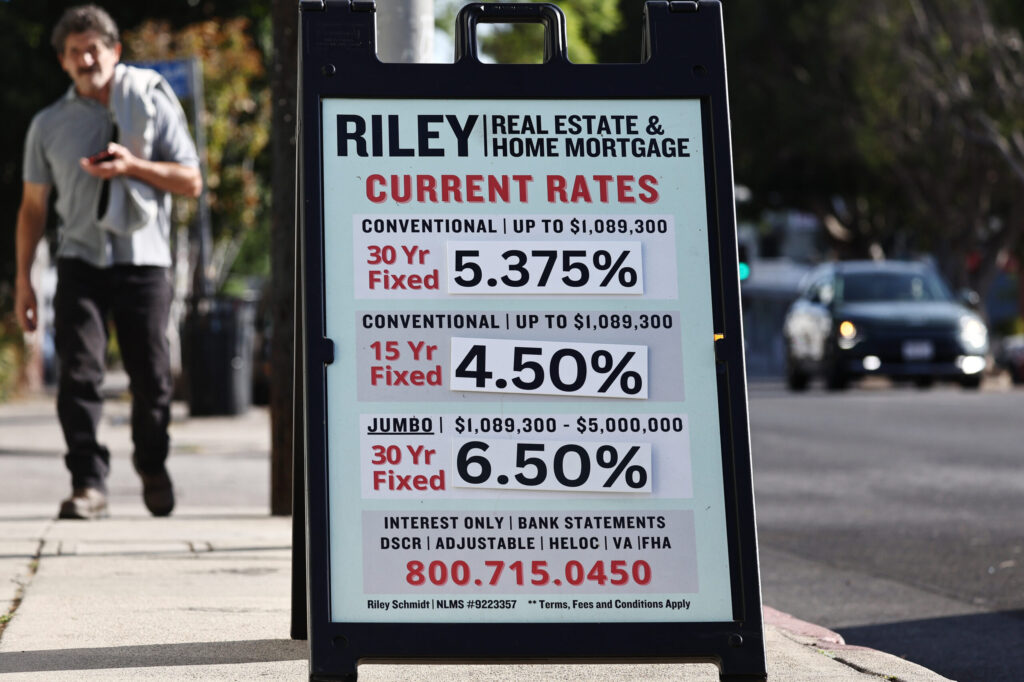Home mortgage rates are posted outside a real estate office in Los Angeles after the Federal Reserve interest rates announcement on Wednesday, Sept. 18, 2024. Federal Reserve Chairman Jerome Powell announced a half-point cut to its benchmark interest rate in the first rate cut since the early days of the COVID pandemic. (Mario Tama/Getty Images)
The Federal Reserve’s first key interest rate cut in four years coincides with another major four-year event: the homestretch of the presidential election.
Fed Chair Jerome Powell downplayed the central bank’s role in the race between Vice President Kamala Harris and former President Donald Trump on Wednesday, in announcing the half-percentage point cut in its benchmark rate. But that didn’t stop the candidates’ campaigns from weighing in, and it could prove a key factor for voters.
“This is my fourth presidential election at the Fed, and it’s always the same. We’re always going to this meeting in particular and asking what’s the right thing to do for the people we serve,” Powell said. “Nothing else is ever discussed.”
The decision to cut for the first time during the Biden Administration indicates the Federal Reserve’s Board of Governors believe the economy has beaten the COVID-19 pandemic-induced wave of inflation that has plagued it since mid-2021. The Fed hiked its key rate 11 times between March 2022 and July 2023.
Inflation peaked at 9.1% in June 2022. The Consumer Price Index, a measure of inflation, rose 2.5% over the past year, according to the latest release from the Bureau of Labor Statistics in August. The unemployment rate was 4.2% in August, down from 4.3% in July, but still much higher than 3.5% in July 2023 when the Fed made its last rate hike.
“We now see the risks to achieving our employment and inflation goals as roughly in balance, and we are attentive to the risks of both sides of our dual mandate,” Powell said.
Wednesday’s was the first in what is expected to be a series of key rate cuts. For now, that benchmark rate is 4.75 to 5%
One member of the Fed’s governing board, Michelle Bowman, dissented with the rest of the group, marking the first time a governor has done so since 2005. Bowman preferred a 25 basis point – or quarter percentage point – cut.
Timing of the rate cut
Both campaigns quickly reacted to the news from the Fed.
Trump, speaking at a crypto-themed bar in New York, said the cut should have been smaller.
“I guess it shows the economy is very bad to cut it by that much, assuming they’re not just playing politics,” the Republican nominee said. “The economy would be very bad or they’re playing politics, one or the other. But it was a big cut.”
Harris, in a prepared statement, was forward-looking.
“While this announcement is welcome news for Americans who have borne the brunt of high prices, my focus is on the work ahead to keep bringing prices down,” the Democratic nominee said. “I know prices are still too high for many middle class and working families.”
Sarah Binder, a senior fellow in governance studies at the nonpartisan Brookings Institution and author of, “The Myth of Independence: How Congress Governs the Federal Reserve,” said there is a long history of presidents pressuring the Fed, from John F. Kennedy to Richard Nixon and Trump, as a president and now as a presidential candidate.
In order to be effective in its role in keeping the economy moving, Binder said, the Fed needs to be trusted as legitimate, and its political support is contingent on doing a good job.
“The Fed doesn’t have the liberty of sitting it out or not doing enough, which can also bring the Fed into politicians’ crosshairs where they really, really don’t want to be,” she said.
Skanda Amarnath, executive director of Employ America, a research group that advocates for full employment, said the Fed should be examining the economic data.
“That’s what they should look at, not where they are in the electoral seasonal cycle,” she said. “I think that’s the case, by and large. I don’t see anything that’s just a real politicization here.”
What a Fed rate cut means for the economy
Many economists and economic advisers have argued for the Fed to cut rates for months to avoid significant damage to the labor market and in the worst case, a recession.
Now, consumers should begin to see lower costs for borrowing money to buy houses, cars and other necessities.
Kitty Richards, senior strategic adviser at Groundwork Collaborative, a progressive think tank based in Washington, D.C., said the Fed should not hold back on cutting rates now that inflation is slowing.
“The Fed pursued four back to back 70-basis-point rate hikes when inflation was heating up. There’s no reason they should allow inertia to hold them back from normalizing rates now that inflation is under control,” she said.
Because shelter makes up so much of inflation, Richards has expressed concern that by keeping rates where they are, mortgage rates have been pushed so high that the housing market is unaffordable for many Americans. This, in turn, affects inflation, she said, creating a vicious cycle.
Dean Baker, senior economist at the Center for Economic and Policy Research, a progressive economic policy think tank, stated that the Fed decision is a good sign for the housing market.
“It is good that the Fed has now recognized the weakening of the labor market and responded with an aggressive cut. Given there is almost no risk of rekindling inflation, the greater boost to the labor market is largely costless,” Baker said in a statement. “Also, it will help to spur the housing market where millions of people have put off selling homes because of high mortgage rates.”
GET THE MORNING HEADLINES DELIVERED TO YOUR INBOX

